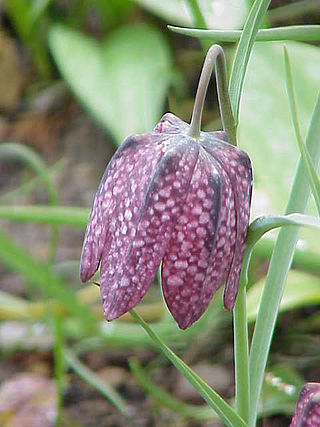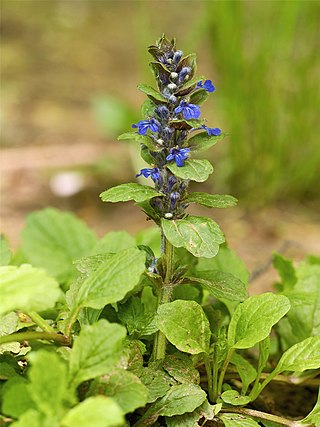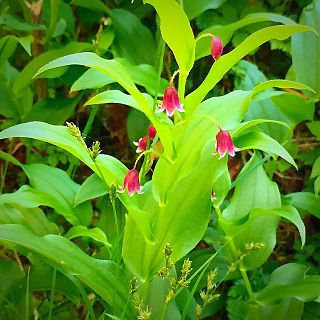
Fritillaria (fritillaries) is a genus of spring flowering herbaceous bulbous perennial plants in the lily family (Liliaceae). The type species, Fritillaria meleagris, was first described in Europe in 1571, while other species from the Middle East and Asia were also introduced to Europe at that time. The genus has about 130–140 species divided among eight subgenera. The flowers are usually solitary, nodding and bell-shaped with bulbs that have fleshy scales, resembling those of lilies. They are known for their large genome size and genetically are very closely related to lilies. They are native to the temperate regions of the Northern hemisphere, from the Mediterranean and North Africa through Eurasia and southwest Asia to western North America. Many are endangered due to enthusiastic picking.

Ajuga, also known as bugleweed, ground pine, carpet bugle, or just bugle, is a genus of flowering plants in the Ajugeae tribe of the mint family Lamiaceae. There are over 60 species of annual or perennial, mostly herbaceous plants. They are native to Europe, Asia, Africa, and Australia.

Arisaema is a large and diverse genus of the flowering plant family Araceae. The largest concentration of species is in China and Japan, with other species native to other parts of southern Asia as well as eastern and central Africa, Mexico and eastern North America. Asiatic species are often called cobra lilies, while western species are often called jack-in-the-pulpit; both names refer to the distinctive appearance of the flower, which consists of an erect central spadix rising from a spathe.

Maianthemum includes the former genus Smilacina and is a genus of perennial herbaceous flowering plants with fleshy, persistent rhizomes. It is widespread across much of North America, Europe and Asia, and may be terrestrial, aquatic or epiphytic. It is characterized by simple, unbranched stems that are upright, leaning or hanging down and have 2–17 foliage leaves. Leaves are simple and may clasp the stem or be short-petiolate. The inflorescence is terminal and either a panicle or a raceme with few to many pedicelate flowers. Most species have 6 tepals and 6 stamens; a few have parts in 4s. Tepals are distinct in most species and all of similar size. Flowers are spreading, cup-shaped or bell-shaped and usually white, but lavender to red or green in some species. Fruits are rounded to lobed berries containing few to several seeds.

Paris is a genus of flowering plants described by Linnaeus in 1753. It is widespread across Europe and Asia, with a center of diversity in China.

Odontochilus is a small genus from the orchid family (Orchidaceae). These terrestrial, mycoparasitic orchids occur from China, Japan, the Himalayas, Southeast Asia, New Guinea and Melanesia. The genus is related to Gonatostylis, endemic to New Caledonia.

Anthoxanthum, commonly known as hornworts, vernal grasses, or vernalgrasses, is a genus of plants in the grass family. The generic name means 'Yellow flower' in Botanical Latin, referring to the colour of the mature spikelets.

Aletris, the colicroot, colicweed, crow corn, or unicorn root, is a genus of flowering plants in the family Nartheciaceae, native to North America and to eastern and southeastern Asia, especially China. It was used as a component in Lydia Pinkham's original Vegetable Compound.

Herminium is a genus of plants in family Orchidaceae, widespread across much of Europe and Asia.

Neottia is a genus of orchids. The genus now includes the former genus Listera, commonly known as twayblades referring to the single pair of opposite leaves at the base of the flowering stem. The genus is native to temperate, subarctic and arctic regions across most of Europe, northern Asia, and North America, with a few species extending into subtropical regions in the Mediterranean, Indochina, the southeastern United States, etc.
Soroseris is a genus of Asian plants in the tribe Cichorieae within the family Asteraceae.

Oreorchis is a genus of flowering plants from the orchid family, Orchidaceae. It is native to Asia. Species currently accepted as of June 2014:
- Oreorchis angustataL.O.Williams ex N.Pearce & P.J.Cribb - Sichuan, Yunnan
- Oreorchis aurantiacaP.J.Cribb & N.Pearce - Myanmar
- Oreorchis bilamellataFukuy. - Taiwan
- Oreorchis discigeraW.W.Sm. - Myanmar
- Oreorchis erythrochryseaHand.-Mazz. - Tibet, Sichuan, Yunnan
- Oreorchis fargesiiFinet - Fujian, Gansu, Hubei, Hunan, Shaanxi, Sichuan, Taiwan, Yunnan, Zhejiang
- Oreorchis foliosa(Lindl.) Lindl. - India, Assam, Nepal, Bhutan, Myanmar, Tibet, Sichuan, Taiwan, Yunnan
- Oreorchis itoana(F.Maek.) Perner - Honshu
- Oreorchis micranthaLindl. - Tibet, Taiwan, Assam, India, Bhutan, Nepal, Myanmar
- Oreorchis nanaSchltr. - Sichuan, Yunnan, Hubei
- Oreorchis nepalensisN.Pearce & P.J.Cribb - Nepal, Tibet
- Oreorchis oliganthaSchltr. - Gansu, Sichuan, Tibet, Yunnan
- Oreorchis parvulaSchltr. - Sichuan, Yunnan
- Oreorchis patens(Lindl.) Lindl. - Japan, Korea, Russian Far East, China
- Oreorchis porphyranthesTuyama - Nepal
- Oreorchis sanguinea(N.Pearce & P.J.Cribb) N.Pearce & P.J.Cribb - Bhutan

Streptopus is a Eurasian and North American genus of flowering plants in the lily family, found primarily in colder and temperate regions. Members of the genus are often referred to as twistedstalk. It is one of the shade-loving genera of the lily family.

Clintonia udensis is a species of flowering plant in the lily family Liliaceae. It is the only species of Clintonia native to Asia. It prefers sparsely forested habitat including the alpine forests of the Himalayas.
Fritillaria cirrhosa, common name yellow Himalayan fritillary, is an Asian species of herbaceous plant in the lily family, native to China, the Indian Subcontinent, and Myanmar.

Fritillaria crassifolia is a Middle Eastern species of bulb-forming flowering plant in the lily family Liliaceae, native to Iran, Iraq, Turkey, Syria, and Lebanon.

Fritillaria gibbosa is a species of herbaceous perennial plant in the lily family Liliaceae. It is native to Afghanistan, Iran, Pakistan, Turkmenistan, and Transcaucasia.

Notholirion macrophyllum is a species of flowering plant in the lily family, Liliaceae. They are bulbous flowering plants originating in Asia. N. macrophyllum is the smallest species in the family, with a height of 20–25 cm. The leaves are basal, 30–40 cm long and about 2 cm wide. from June to August N. macrophyllum produces a racemose inflorescence bearing 2–4 pale violet to purple or red, bell-shaped, hermaphrodite, flowers with dark purple flecks in the throat, about 5 cm in length. After flowering the plant produces a capsular fruit.

Fritillaria reuteri is a perennial herbaceous bulbous plant, distributed in Turkey and Iran. It is a species in the genus Fritillaria, in the family Liliaceae. It is placed in the subgenus Fritillaria.

















